
Jurgen Klopp wanted a midfield change at Liverpool – instead he got a revolution
It transpires there are different kinds of problems involving the Liverpool midfield. Last season was a tale of the aged, the injured, the inconsistent and the incoherent, the malfunctioning midfield that meant a champion team suddenly looked disjointed and disappointing. If it was an exaggeration to say Liverpool didn’t have a midfield last season, in a sense they don’t have one now. Or not their old midfield, anyway. An exodus was partly planned, partly thrust upon Jurgen Klopp by Saudi Arabia’s injection of money and unexpected wish to acquire defensive midfielders. Perhaps Jordan Henderson and Fabinho will not be able to gegenpress in 45-degree heat, but it is not Klopp’s immediate concern; if the plan was for two new faces to feature in his first-choice midfield, a complete overhaul has become necessary. He wanted change and got a revolution instead. Of the six midfield departures, Arthur Melo – he of the solitary, 13-minute appearance – is still more of an afterthought now. Naby Keita and Alex Oxlade-Chamberlain are cases of what might have been, some of their potential left unrealised amid spells on the treatment table. But James Milner, Henderson and Fabinho were three of the quintessential Klopp midfielders: the fourth, Gini Wijnaldum, left in 2021. Between them, they played 1063 times for Klopp; they rank second, fourth, 17th and 11th respectively for most appearances in the German’s managerial career and, even including his days at Mainz and Borussia Dortmund, no central midfielders have lined up as often for him. They were the men who made his teams work, the rhythm section of his heavy-metal football, leaving the glamorous jobs to others. There were always other midfielders, but they were usually those trusted for the big occasions. In the 2018 Champions League final, Milner and Wijnaldum flanked Henderson. Come the 2019 final, when Fabinho had joined, he had the anchor role, with Henderson and Wijnaldum either side and Milner deployed as a specialist finisher, using his experience to see out the victory. The Dutchman was a different sort of finisher on Klopp’s greatest night: initially benched for the second leg against Barcelona, Wijnaldum came on at half-time, as Milner switched to left back, to score twice in a 4-0 triumph. All of which was uncharacteristic. Those 1063 appearances produced just 71 goals, a total that would have been smaller still but for Milner’s excellent penalty-taking. There were 99 assists, too, but to put that in context, Kevin De Bruyne got 149 on his own for Manchester City since Klopp’s appointment at Anfield, plus 92 goals. It illustrates it is a comparison of opposites. The definitive Klopp midfielders were the selfless support acts, defined by what they did not do – score, for instance – and where they did not go: the penalty area, or not often anyway. The full backs usurped them as creators; the goals came largely from the front three; if most great teams have at least one goalscoring midfielder, and Klopp’s Dortmund protégé Ilkay Gundogan developed a potent streak for Pep Guardiola and alongside De Bruyne, his Liverpool were the exception. His core four at Liverpool were the masters of the unspectacular: workhorses who ran many a mile, though often in relatively short distances, experienced figures who were experts at positional discipline. They were a reason why, at their best, Liverpool were rarely caught on the counter-attack, even when Andy Robertson and Trent Alexander-Arnold were in the final third. Liverpool were never a pure possession team but Wijnaldum, in particular, tended to have very high pass-completion statistics. It was in part because they were rarely charged with playing the most ambitious balls but Wijnaldum, especially, made playing in a Klopp midfield look deceptively simple: as his far greater goalscoring return for the Netherlands showed, his was a self-sacrificial role, playing within himself with the intelligence to make the tactics of a narrow 4-3-3 work. In one respect, Fabinho is the anomaly. He was the specialist defensive midfielder. The other three were all multifunctional grafters, their broader skillsets equipping them for many a task (often playing full back in Milner’s case). None was an out-and-out playmaker, but they brought combativity and understated chemistry. It amounted to a triumph of all-rounders: whereas some midfields were combinations of players with contrasting attributes, Liverpool prospered with those with similar strengths. Maybe an ethos has changed now. Klopp’s first two summer midfield additions, Alexis Mac Allister and Dominik Szoboszlai, offer the prospect of more goals than his quintessential quartet ever provided: after the shift in formation towards the end of last season, when Alexander-Arnold came to join Fabinho at the base of the midfield, Klopp referred to his more advanced pair as “two [No] 10s”. And if Wijnaldum could play as a genuine No 10 elsewhere, Milner and Henderson rarely did. Mac Allister and Szoboszlai, however, can meet the description. But maybe the newcomers will discover they are charged with copying their predecessors. Perhaps the beginning of the end for Klopp’s original midfield can be traced to the signing of Thiago Alcantara, to the sign he wanted something more stylish. But suddenly, an era has ended. Klopp’s four favourite workhorses are all gone. There may not be an all-conquering midfield quite like them again. Read More Jurgen Klopp responds after Kylian Mbappe to Liverpool rumours Liverpool name Virgil van Dijk as new captain after Jordan Henderson exit Liverpool confirm Fabinho transfer in latest Saudi Arabia move Lauren James on song as England thrash China – Tuesday’s sporting social Sadio Mane’s swift decline reaches new low Liverpool make second Romeo Lavia bid as Southampton set transfer price
1970-01-01 08:00

Ousmane Dembele wants to join PSG, says Barcelona boss Xavi
Ousmane Dembele has told Barcelona that he wants to leave to join Paris St Germain, according to manager Xavi. The Ligue 1 side have made the 26-year-old an offer that Barca “cannot match” and he has informed his manager that he wishes to move. The France international has a £43million release clause in his contract which PSG have reportedly triggered, shortly before the terms of his deal stipulated the figure would rise to £86m. Talks have taken place between the parties and Dembele has made up his mind that his future lies away from Barca, whom he joined from Borussia Dortmund for £125m in 2017. “Dembele came and told me he wanted to leave,” said Xavi. “He has an offer from PSG that we cannot match.” He has played 185 times for the club and has won three LaLiga titles during his six-year stay. Read More Charity boss speaks out over ‘traumatic’ encounter with royal aide Ukraine war’s heaviest fight rages in east - follow live
1970-01-01 08:00
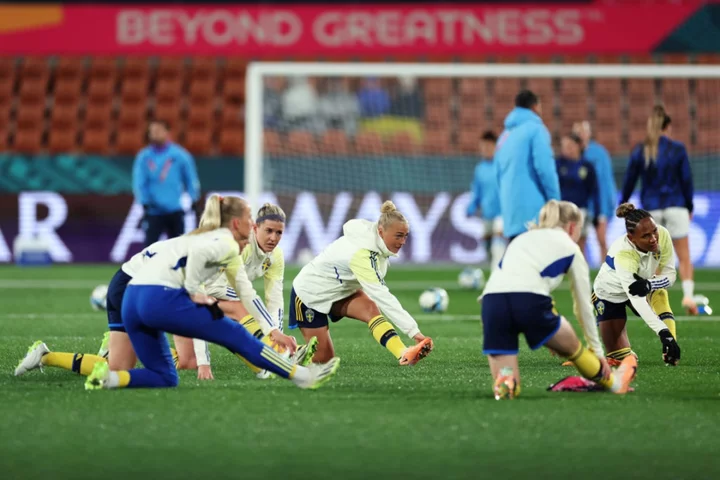
Women’s World Cup 2023 LIVE: Lionesses reaction and latest news as Argentina and Brazil fight for last 16
The group stage of the 2023 Women’s World Cup is almost complete, with just three more quartets needing to wrap up their opening games and discover which nations make the knockouts. On Wednesday it’s the turn of Argentina to try and force their way through to the last 16 as they face Sweden, while Italy play South Africa also needing a result to progress. Later, Brazil must overcome Jamaica to seal progression from Group F after being beaten by France - who are top and face minnows Panama. Meanwhile, Lauren James shone again on Tuesday with two stunning goals as England put in their best performance of the Women’s World Cup so far to sweep aside China 6-1 and march into the last 16. USA only just managed to sneak through with a draw against Portugal, leading to criticism from former stars. Follow all the latest news and match updates below: Read More Genius Lauren James takes over Women’s World Cup — but England must learn from rivals Sarina Wiegman’s brave England switch solves key Women’s World Cup problem USA’s narrow escape spells the end of Women’s World Cup dominance
1970-01-01 08:00

Why Axel Disasi could solve Mauricio Pochettino’s defensive problems at Chelsea
When it was confirmed in mid-July that Wesley Fofana would face a significant period on the sidelines owing to an ACL injury, Chelsea started to be linked with a host of centre-backs to replace the Frenchman. Harry Maguire was a reported target, so too was Blues academy product Marc Guehi. However, on Sunday evening, reports started to circulate that Chelsea had an agreement in principle with Monaco for towering France international Axel Disasi. The 25-year-old has been on Premier League radars in recent months, with Manchester United and Newcastle both credited with an interest in the Gonesse-born centre-back. Chelsea have since taken the plunge on the defender, bringing him in for €45m. That in itself serves to highlight the extent of Fofana's injury, but even so; Chelsea couldn't afford to pass up the chance to secure Disasi's services. Even with his compatriot available, Mauricio Pochettino's top quality options at the heart of the defence are thin on the ground. Levi Colwill, who is set to pen a new deal at Stamford Bridge, should go on to become a mainstay in the Blues backline, but a partner for the 20-year-old was key. Trevoh Chalobah isn't quite of the standard expected for a club seeking to return to the Champions League, while the west London outfit can't rely on 38-year-old Thiago Silva to manage the backline for another season, particularly in a four-man defence. Benoit Badiashile will return sooner rather than later, but he'll need some time to get up to speed under Pochettino having missed much of pre-season due to a hamstring issue. For the right-sided centre-back role, Disasi can be viewed as a superb acquisition. Standing at 6ft 3in, the France international maximises his stature having won the second most aerial duels (97) of defenders in Ligue 1 last season. And he was consistent in beating opponents in headed battles, too. Of the 143 players to contest 50 or more aerial duels, Disasi's aerial success rate of 70.3% ranked ninth in the division. Considering Chelsea returned an aerial success rate of just 52.1% last season, Disasi's dominance in the air will certainly boost that return. There's also a willingness to get the ball forward quickly from deep. Not only did Chelsea struggle for goals last season, hitting the back of the net 38 times in the Premier League, but they were compounded by an inability to put an opponent to the sword at speed. No team scored fewer counter-attacking goals than Chelsea (1) in England's top tier last term, and even that came in a 4-1 defeat at Manchester United back in May. Disasi, though, is one willing to pick a pass from range, and does so to a decent standard to help quickly turn defence into attack. Indeed, 141 accurate long balls ranked 14th of outfield players in France's top tier last term, and this in itself played a part in Monaco scoring seven counter-attacking goals; only champions PSG (10) netted more. Dominant in the air and sound with the ball at his feet, Disasi seems the perfect fit for a Chelsea side that will seek to control matches where possible. Another key reason behind the drive to sign Disasi, though, will have been his versatility. Primarily a centre-back, he’ll line up at the heart of the defence with everyone fit in Pochettino's 4-2-3-1 setup, but players who can operate in multiple positions are a precious commodity in the modern game. As such, Disasi's ability to play at right-back as well as centre-back will have been another reason behind Chelsea's interest. The departure of Cesar Azpilicueta over the summer means the Blues needed another defender to operate in a couple of roles, and a defensive-minded right-back is a handy squad option. Pochettino has also previously used a three-man backline during his time at Tottenham, a system that does suit the full-backs at his disposal, so the ability to switch between two formations is ideal. Disasi's flexibility will help Pochettino's decision making when it comes to tinkering with his side, particularly in-play, and it cannot be overstated how important this positional interchangeability is for Chelsea. Given how often managers tinker with their setup across the 90 minutes, the potential ability to swap between a four-man and a three-man defence will aid the Blues, not just on a week-by-week basis, but across the season. There are concerns over the defensive side to his game, particularly when up against direct attackers in one-on-one situations, yet from an offensive perspective; Disasi will benefit Chelsea. Given the right protection in front of him, Disasi should be given the crucial time on the ball to help set the Blues on the front foot. Alongside ball-playing star-in-the-making Colwill, Chelsea will have a solid centre-back foundation to help in their quest to return to the Champions League. Read More Chelsea and Barcelona push for Kylian Mbappe player-plus-cash transfer deals Football rumours: Tottenham name Harry Kane price as Bayern Munich prepare bid Chelsea have a Conor Gallagher problem and Tottenham could be the perfect solution Chelsea agree fee with Monaco for France international defender Axel Disasi Football rumours: Chelsea make revised offer for Brighton’s Moises Caicedo England’s attack goes from tired to inspired as new-look front three devastates China
1970-01-01 08:00
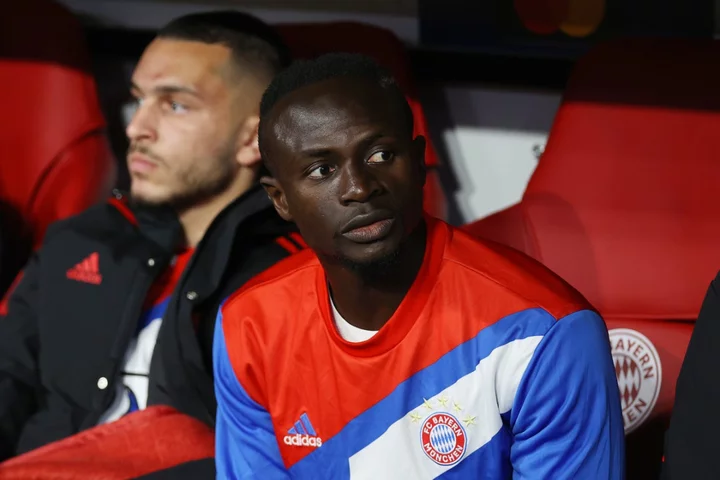
Sadio Mane’s swift decline reaches new low
Sadio Mane was maybe only inches from the Ballon d’Or; the inside of the Paris post, which his shot struck in the Champions League final; the fingertips of Thibaut Courtois, tipping a goalbound effort on to the woodwork. Inches from immortality, perhaps, from being only the second African to become officially the best player in the world. And if it is not certain he would have topped the poll, the eventual runaway winner Karim Benzema was propelled to pre-eminence by Champions League glory in a year when the poll took place before the World Cup. As it was, Mane was named the second-finest player on the planet in 2022. He finished the 2022-23 campaign as perhaps 16th in line at Bayern Munich: 15 others took the field in the win at Koln that clinched the Bundesliga, with the teenager Mathys Tel and veteran Eric Maxim Choupo-Moting summoned from the bench while Mane remained an unused substitute. He had been the fifth substitute used the previous week, sent on with four minutes to go in defeat to RB Leipzig. The decline of Mane has been a swift, undignified and unexpected affair. A lucrative one, too, given that Bayern are paying him far more than Liverpool did and Al Nassr will in turn pay him rather more again, after he joined the migration to Saudi Arabia. Mane represents one of the Pro League’s flagship signings, but is an arrival with a difference: like many others, he is in his thirties, but whereas Benzema is 35 and could argue his ambitions were realised with Real Madrid and Cristiano Ronaldo is now 38, albeit stung by the recognition the European elite did not want him when he left Manchester United, the Senegalese is only 31. So, if only for another couple of months, is Roberto Firmino, but Mane’s old sidekick’s race had appeared run. He, on the other hand, was seemingly at his peak. This, it is safe to say, is not what Mane had planned when he teased his audience ahead of the Champions League final, saying he would reveal his future after it, and when, after emerging from Mohamed Salah’s shadow to become the brightest star at Anfield, he declared he “would be the most happy player in the world” to win the Ballon d’Or. Klopp can be loyal to players who have served him well and few were as influential as the catalytic Mane. There was no hint of gloating about a decision to leave that backfired, but nor was there a pretence Mane has prospered in Bavaria. “I don’t know what went wrong,” the Liverpool manager said on Tuesday. “When Sadio left us he left on a high in really good shape: world-class player, no shadow of a doubt. To fulfil your full potential everything has to fall in place, you need a bit of luck and that wasn’t the case.” Certainly there was misfortune as injury ruled Mane out of the World Cup. His old manager nevertheless could have pointed out that most of the great Klopp players are only great Klopp players: there are notable exceptions, such as Robert Lewandowski, Mats Hummels and Ilkay Gundogan, but they are outnumbered by those who never scaled such heights elsewhere or under anyone else. That category now includes Mane. “Basically, Sadio had an unsatisfactory season and fell short of expectations,” Thomas Tuchel said last month. “The player knows my opinion and the opinion of the club.” Tuchel sounded more forgiving before Bayern face Liverpool in Singapore, a reunion without Mane after he has left both clubs in successive summers. “I totally understand that he feels hurt,” he said. “I also don’t feel happy. We didn’t bring it to the full potential which is my responsibility.” Mane suffered after Tuchel’s appointment, starting just four times, scoring just once and being suspended by the club for punching Leroy Sane after the defeat to Manchester City. Regime change worked against him, but his tally of goals for the sacked Julian Nagelsmann – 11 – was also underwhelming. As Klopp hinted, circumstances can play a part. Mane could flourish in a system without a conventional striker at Liverpool, with Firmino usually the false nine before the Senegalese finished his Anfield career in that role. But Bayern, where a No 9 has traditionally been a pillar of the team, the experiment of replacing Lewandowski with a more fluid forward line failed: hoping some combination of Mane, Sane, Serge Gnabry, Thomas Muller and Jamal Musiala could dovetail slickly instead made Choupo-Moting more important than ever before and led to a summer pursuit of Harry Kane. Bayern is a club with its own dynamics, with entrenched power bases in the dressing room, a club with stars and yet one who did not buy those of Mane’s stature. Not since Arjen Robben 13 years earlier had they bought such a major attacker who was neither German nor recruited from the Bundesliga. If Mane was the outsider, he has headed out after a lone, increasingly ignominious year. And the 193 votes Mane received in the Ballon d’Or for 2022 are likely to be 193 more than he gets for 2023. Read More Liverpool make second Romeo Lavia bid as Southampton set transfer price Jurgen Klopp responds after Kylian Mbappe to Liverpool rumours Liverpool name Virgil van Dijk as new captain after Jordan Henderson exit Why Axel Disasi could solve Mauricio Pochettino’s defensive problems at Chelsea Football rumours: Harry Kane will stay if no deal agreed by start of season Young England fans react to World Cup win over China: ‘We’ve got our mojo back’
1970-01-01 08:00
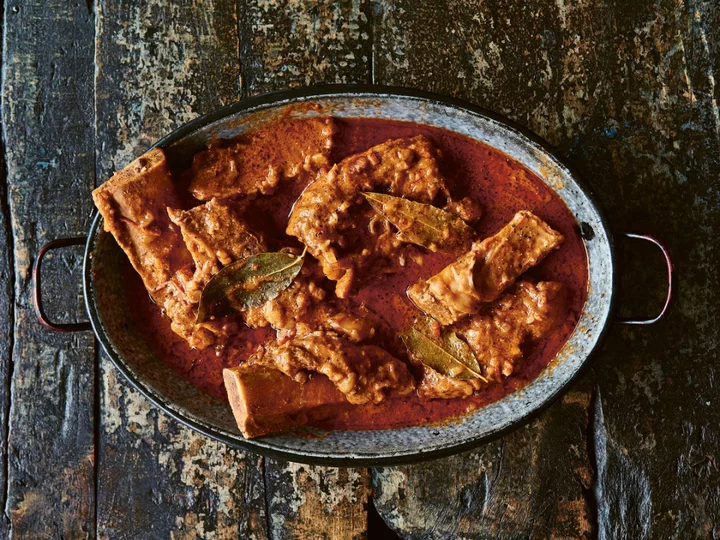
Low and slow: Braised beef short ribs in peanut and coconut milk
The coconut is a truly tropical fruit, which spread on its own to tropic coastal zones all over the world. The flesh and milk from coconuts are widely used in African cooking in relishes, sauces, desserts – you name it,” says Maria Bradford, author of Sweet Salone. Braised beef short ribs in peanut and coconut milk Serves: 5 Ingredients: 5 beef short ribs 2 tbsp sunflower oil Steamed coconut rice or fonio, to serve Salt For the peanut and coconut sauce: 2¼ tsp cumin seeds ¾ tbsp coriander seeds 1 tsp West African Pepper Blend (see below) ¾ tbsp curry powder 3½ tbsp coconut oil 2½-3 large onions, finely chopped 25g garlic, grated 25g ginger, grated 1-2 Scotch bonnet chillies, seeds left in, finely chopped 45g tomato purée 250g fresh tomatoes, chopped ½ tsp coconut sugar 300ml coconut milk 3 bay leaves 3 thyme sprigs 100g unsalted smooth peanut butter (use one without palm oil) 500ml beef stock For the West African pepper blend: 2½ grains of paradise 2 tbsp black peppercorns 2 tbsp white peppercorns 1 tbsp cubeb pepper 3 tbsp allspice berries Method: 1. For the West African pepper blend: toast all the peppercorns in a dry pan over medium heat until fragrant. Allow to cool, then grind in a spice grinder or pestle and mortar. Store in an airtight jar. It will stay fresh for up to three months. 2. Preheat the oven to 150C/130C fan/300F/gas mark 2. 3. For the sauce, lightly toast the cumin and coriander seeds in a hot, dry frying pan until aromatic. Grind in a pestle and mortar or food processor, combine with the West African Pepper Blend and curry powder and set aside. 4. For the short ribs, heat the sunflower oil in a large frying pan over high heat. Season the short ribs with salt and add to the hot pan, frying on each side until golden brown, turning regularly. The aim here is not to cook them but to sear them and add flavour. Make sure to brown them well all over, then remove and set aside. 5. For the sauce, heat the coconut oil in a large heavy-based casserole or Dutch oven (use one with a lid). Add the onions and cook gently over low-medium heat until caramelised and very sweet. This will take up to 30 minutes and it’s important not to rush this process. Add the garlic, ginger and chillies and cook, stirring, for five minutes more. Add the spices and cook for a further five minutes on low heat, stirring to prevent sticking. 6. Add the tomato purée, chopped tomatoes, coconut sugar, coconut milk, bay leaves, thyme sprigs, peanut butter and beef stock to the pan. Stir well to combine, bring to the boil then add the short ribs to pan, making sure they’re all covered by the sauce. 7. Cover with the lid and cook in the oven for four to five hours or until the meat is tender and falling off the bone. Remove from the oven, taste and add salt if needed. Serve with steamed coconut rice or fonio. ‘Sweet Salone’ by Maria Bradford (Quadrille, £30). Read More A week’s worth of summery recipes (even when the weather is dire) The dish that defines me: Frank Yeung’s prawn wontons Discovering Sierra Leonean flavours in South London How to make cassava chips How to make a traditional Sierra Leonean rich cake In Horto: Hearty, outdoorsy fare in a secret London Bridge garden
1970-01-01 08:00

Discovering Sierra Leonean flavours in South London
Chef Maria Bradford remembers the first time she came to Peckham market. Originally from Sierra Leone, she moved to England in her late teens, and after four years she was desperately homesick. She was living in Kent and felt far removed from her home of Freetown – until she went to Peckham in South London. “The first time I ever came to Peckham, it was such a shock. I didn’t think a place existed like that [in England] – it reminded me so much of the hustle and bustle in Freetown,” she says. “All of a sudden, you get off the train and you come to this place and you’re like, Oh my God. I’m home.” Bradford, now 42, says she “desperately needed” a place like Peckham, and has been coming to the market regularly ever since. We’re back there today – on a hot but overcast London day, and Bradford is showing me how to pick out the best Sierra Leonean ingredients. We go on a weekday, as she says a weekend would take us a lot longer to get round, once she’s spoken to all the aunties in the community who want a chat. As we walk through the market, Bradford starts talking about Sierra Leonean cuisine. “I would say it’s quite healthy. We eat lots of leaves and greens, and we eat a lot of seafood as well. There’s lots of layers to Sierra Leonean food, because we mix things like smoked fish and meat in the same dish… Because we use fish more as a flavouring.” The words that spring to mind when she thinks about the food of her homeland? “Healthy, homely, comforting.” Bradford continues: “I don’t know if that’s because I’m Sierra Leonean, it brings me that calmness and home feeling. That warmth. It feels like I’m sitting at the back of our house with my mum, my nan, my grandmother, my aunties and everyone – we’re sitting around cooking, and it feels like comfort.” When she really wants to feel comforted and soothed, Bradford whips up a bowl of egusi soup (egusi – also known as melon seeds – is a thickener, and the recipe includes oxtail, goat meat, white sorrel, smoked barracuda and Scotch bonnet chillies) that Bradford says is like a “food hug, because when you eat it all you want to do is sleep”. After looking at some of the outdoor stalls full of colourful produce – bright pumpkins, squat varieties of cucumber, browning plantains – we go into Bit By Bit, a Sierra Leonean shop run by Sarian Karim-Kamara. Karim-Kamara immediately starts singing Bradford’s praises (“you’re flying the Sierra Leonean flag – we’re so proud of you!”) and thumbing through her new cookbook, called Sweet Salone – a nickname for the country. The shop is full of speciality ingredients you’ll need to make some of the recipes in the book – from the brightly coloured red palm oil (a staple in the country) to frozen cassava leaves and smoked barracuda. Bradford is keen to promote local shops such as this one, saying: “People are really friendly and want to talk about the ingredients – they don’t just know about the ingredients, they know what to do with it, how to promote it… It’s nice to step into these shops and have conversations, because you might learn so much more than what you bargained for.” As well as running the shop, Karim-Kamara is an FGM campaigner – she’s just launched a new campaign with the Mayor of London – and runs a food bank out the back. “For three years I’ve been supporting refugees and asylum seekers, but the food bank is open now to the community because everyone is struggling,” she says. Karim-Kamara adds she doesn’t talk much about it because “some people are really shy… The way we do the service is people come to the back and help themselves”. We move onto another shop selling West African ingredients – including jute leaves, black velvet tamarind and white hibiscus – and Bradford strikes up a conversation with the shopkeeper, who says she’ll pre-order the cookbook and give it to her daughter, so traditional Sierra Leonean cooking continues down the generations. “The children that are born here, they don’t really know how to cook the traditional stuff,” Bradford says after this exchange. “They’ll be more gearing towards the Afro-fusion side. It’s really important we keep the core traditional stuff, and also keep it separate.” But Bradford is an advocate for Afro-fusion dishes as well, describing it as “taking traditional Sierra Leonean ingredients and using techniques we wouldn’t necessarily use to extract as much flavour from those things”. After working as an accountant for 10 years (which she hated), Bradford did an evening course at prestigious cooking school Leiths and set up a catering company, and now uses her classical training to give a spin on the dishes she grew up eating. Examples of Afro-fusion recipes in the book include cassava chips with truffle and Parmesan, and the oxtail pepe stew – which has red wine added, a French technique she drew upon to deepen the flavours. Whether it’s traditional dishes or Afro-fusion flavours, Bradford – who is still based in Kent – uses cooking to connect with her roots. It started when she first moved to the UK and was missing home. “So I started cooking, making stuff I like to eat with stuff I can get my hands on,” she says. One of the first dishes she made was peanut soup (“you can get peanut butter anywhere, and you can pick up chicken anywhere”) and it grew from there. “Cooking and throwing those things together to feel like you’re home, connecting back to Sierra Leone.” ‘Sweet Salone’ by Maria Bradford (Quadrille, £30). Read More A week’s worth of summery recipes (even when the weather is dire) The dish that defines me: Frank Yeung’s prawn wontons How to make cassava chips How to make a traditional Sierra Leonean rich cake How to make West African brasied beef shorts in peanut and coconut milk In Horto: Hearty, outdoorsy fare in a secret London Bridge garden
1970-01-01 08:00
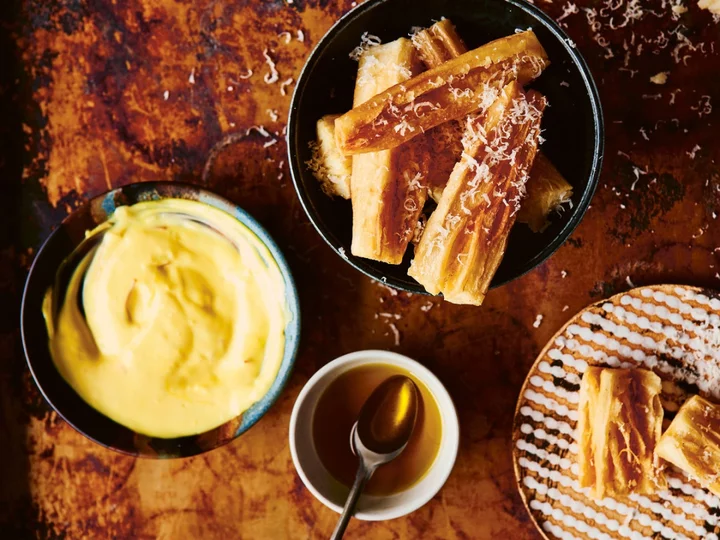
How to make cassava chips
If you are not familiar with cassava, it is tuber with a waxy, bark-like outer skin and a starchy centre,” explains Maria Bradford, author of Sweet Salone. It’s a staple in Sierra Leonean households, and Bradford adds: “This recipe combines my beloved cassava with European ingredients, such as Parmesan and truffle. “The flavour is every bit as good as potato chips, if not better, with just the right subtle hint of earthy truffle. They’re crispy on the outside, tender on the inside, perfectly salted and mixed with Parmesan to take them over the top. A simply luxurious snack!” Cassava chips with truffle oil, Parmesan and saffron mayo Serves: 6-8 Ingredients: For the cassava chips: 1kg cassava 1 tsp sea salt 60g parmesan, grated Sunflower oil, for deep frying Parmesan shavings, to serve 3 tbsp white truffle oil For the saffron mayo: Large pinch of saffron 2 tbsp hot water 300g good-quality mayonnaise 1-2 cloves garlic, finely chopped Method: 1. To peel the cassava, cut the cassava crosswise into five to eight-centimetre pieces. Using a sharp knife, cut lengthwise through the bark-like exterior and into the pink skin beneath. Place the tip of the knife under the skin to loosen it and pull off the skin and bark. Cut into chunky chip-sized pieces. 2. As you work, rinse the cassava and put the pieces in a large saucepan with cold water so it doesn’t discolour. When all are cut to size, add the salt and bring the pan of water to the boil. Boil until the cassava pieces are tender when pierced with a knife, about 25 minutes. 3. Meanwhile, make the saffron mayo. Crumble the saffron threads into a small bowl and pour over the hot water. Let it steep for 10 minutes. 4. Stir the mayonnaise and garlic together in a bowl. Add the saffron water and stir to combine. Taste and season with salt. 5. When the cassava is tender, drain it in a sieve and set aside until completely dry. 6. Heat the oil for frying in a deep, heavy-based pan no more than half full. To test if the oil is hot enough, drop a small breadcrumb into the hot oil. It should sizzle and turn brown in 20 seconds. 7. Working in small batches so as not to overcrowd the pan, fry the cassava chips until nicely golden, five to 10 minutes per batch. Remove with a slotted spoon and drain on a baking sheet lined with paper towels. 8. Toss the fried cassava chips with grated Parmesan and the white truffle oil. Serve with the saffron mayo on the side. ‘Sweet Salone’ by Maria Bradford (Quadrille, £30). Read More A week’s worth of summery recipes (even when the weather is dire) The dish that defines me: Frank Yeung’s prawn wontons Discovering Sierra Leonean flavours in South London How to make a traditional Sierra Leonean rich cake How to make West African brasied beef shorts in peanut and coconut milk In Horto: Hearty, outdoorsy fare in a secret London Bridge garden
1970-01-01 08:00

How to make a traditional Sierra Leonean rich cake
I have fond childhood memories of the preparation process involved in making this cake,” says Maria Bradford, author of Sweet Salone. “We would often cream the butter and sugar by hand using a wooden spoon in Sierra Leone and this could take hours, but the end result was worth it. The next step is where Sierra Leonean ingenuity comes in. We would butter the inside of empty powdered milk tins and use these as baking tins. “The cake was then baked outside in the open on an improvised oven, with a large pot placed on top of three stones, with sand spread across the base. We put the cake tins on top of the hot sand in the pot and put the lid on. Our fuel was wood or charcoal, and when the fuel was very hot, we put lumps of hot charcoal on top of the lid of the pot to brown both the top and bottom of the cake.” Sierra Leonean-style rich cake Serves: 6-8 Ingredients: 150g butter, plus extra for buttering 150g caster sugar 3 eggs 50g plain flour 150g self-raising flour 1-2tbsp full-fat milk Finely grated zest of 1 orange 1 tsp natural orange flavouring (I use Steenbergs’ Organic Orange Extract) Method: 1. Make sure all the ingredients are at room temperature. Generously butter an 18-centimetre cake tin. Preheat the oven to 180C/160C fan/350F/gas mark 4. 2. Using an electric hand-mixer, cream the butter and sugar together in a large mixing bowl until the mixture is pale, light and fluffy (10-15 minutes). Don’t rush this step; the more thoroughly the butter and sugar are combined, the lighter the cake will be. Add the eggs, one at a time, beating the mixture well between each addition. Add one tablespoon of flour with the last egg to prevent curdling. 3. Sift both flours into the bowl and gently fold in, adding just enough milk to give a mixture that drops slowly from a spoon when the spoon is held away from the bowl. Fold in the orange zest and orange flavouring. 4. Pour the batter into the prepared tin and bake for 30-40 minutes, or until golden-brown on top and a skewer inserted into the centre comes out clean. 5. Turn the cake onto a cooling rack and leave to cool. Slice and enjoy. ‘Sweet Salone’ by Maria Bradford (Quadrille, £30). Read More A week’s worth of summery recipes (even when the weather is dire) The dish that defines me: Frank Yeung’s prawn wontons Discovering Sierra Leonean flavours in South London How to make cassava chips How to make West African brasied beef shorts in peanut and coconut milk In Horto: Hearty, outdoorsy fare in a secret London Bridge garden
1970-01-01 08:00

Football rumours: Harry Kane will stay if no deal agreed by start of season
What the papers say Harry Kane will stay at Tottenham if no deal has been done before the club’s Premier League opener against Brentford. The Independent reports an £85 million bid for the England striker, 30, from Bayern Munich has been rejected as they seek £100 million. And according to the Evening Standard, Kane believes it would be unfair to leave after the start of the campaign. France midfielder Tanguy Ndombele could be heading away from Tottenham. According to the Daily Mirror, Galatasaray are looking to agree an £11 million move for the 26-year-old. Chelsea have added more names to their list of transfer targets with a pair of midfielders, according to The Times. US midfielder Tyler Adams, 24, from Leeds United and Ajax’s Mexican Edson Alvarez, 25, are the latest to interest the Blues. Leeds are lining up a move for full-back Brandon Williams, 22, from Manchester United, reports The Independent. Social media round-up Players to watch Michael Olise: The Crystal Palace forward, 21, is seen as a potential replacement for Riyad Mahrez at Manchester City. Michail Antonio: Everton could step in for the West Ham striker, 33, who has not secured a deal in Saudi Arabia. Read More Charity boss speaks out over ‘traumatic’ encounter with royal aide Ukraine war’s heaviest fight rages in east - follow live
1970-01-01 08:00

Projected Iowa State starting QB accused of betting on Cyclones sports, including football
Hunter Dekkers, the expected Iowa State starting quarterback, is facing allegations of breaking NCAA regulations by placing bets.There is less than one month until the college football season gets underway, and Iowa State is already facing immediate scrutiny over who its starting quarterback mig...
1970-01-01 08:00
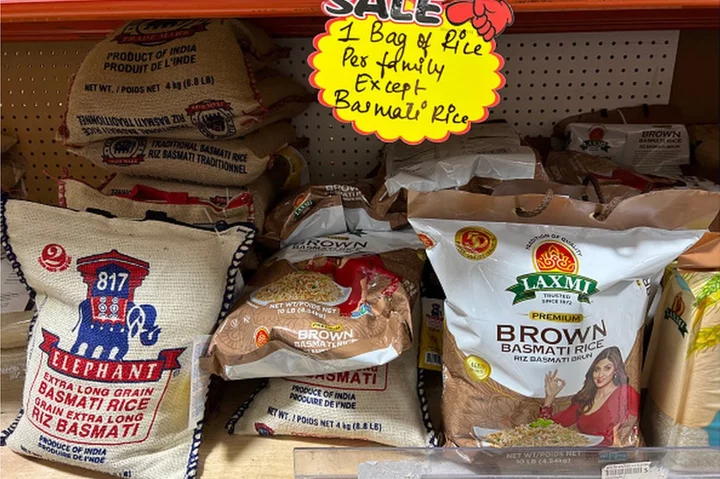
Why India's rice ban could trigger global food crisis
The ban could compound a worldwide rise in rice prices for a host of reasons, experts say.
1970-01-01 08:00
